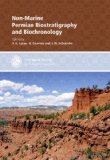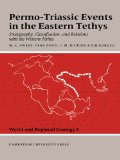Permian
- A close-up view of the Permian-Triassic boundary based on expanded organic carbon isotope records from Norway (Trondelag and Finnmark Platform)

- A comparison of the biological, geological events and environmental backgrounds between the Neoproterozoic-Cambrian and Permian-Triassic transitions

- A new vertebrate Lagerstätte from the Lower Permian of France (Franchesse, Massif Central): palaeoenvironmental implications for the Bourbon-l'Archambault basin

- A palaeoenvironmental analysis of Permian sediments in Minorca (Balearic Islands, Spain) with new palynological and megafloral data

- Autochthonous Upper Permian (Midian) Carbonates in the Western Sakarya Composite Terrane, Geyve Area, Turkey: Preliminary Data

- Calcium isotope constraints on the end-Permian mass extinction

- Carbon biogeochemical cycle across the Permian - Triassic boundary strata and its implications: isotope record from the Changhsingian Stage at Meishan, south China

- Climatic and biotic upheavals following the end-Permian mass extinction

- Das Perm
- Devonian and Permian fossils from the Falkland Islands in the biostratigraphy collection of the British Geological Survey

- Did the Wood Roach Cause the Permian Aridity, Red Beds, and Conifer Rise?
- Ecological evolution across the Permian/Triassic boundary at the Kangjiaping Section in Cili County, Hunan Province, China

- End-Permian mass extinction pattern in the northern peri-Gondwanan region

- Environmental change in the Permian of Spitsbergen: From a warm-water carbonate platform (Templet and Sørfonna members, Gipshuken Formation) to a temperate, mixed siliciclastic-carbonate ramp (Vøringen Member, Kapp Starostin Formation)

- Evidence for atmospheric carbon injection during the end-Permian extinction

- Explosive eruption of coal and basalt and the end-Permian mass extinction

- Facies, microfossils (smaller foraminifers, calcareous algae) and biostratigraphy of the Hueco Group, DoÑa Ana Mountains, Southern New Mexico, USA

- Foraminiferal survivors from the Permian-Triassic mass extinction in the Meishan section, South China

- Global Boundary Stratotype Section and Point (GSSP) for the base of Changhsingian Stage (Upper Permian)

- Global Stratotype Section and Point (GSSP) for the boundary between the Capitanian and Wuchiapingian Stage (Permian)

- Glossopterid megafossils in Permian Gondwanic non-marine biostratigraphy

- International Symposium on the Global Stratotype of the Permian-Triassic Boundary and the Paleozoic-Mesozoic Events
- Large increase of δ13Ccarb-depth gradient and the end-Permian mass extinction

- Murchison’s first sighting of the Permian, at Vyazniki in 1841

- National Comission for Stratigraphy of Belgium - Subcommission Permian-Trias-Jurassic
- New vistas on animal–plant–fungal interactions in the Permian–Triassic of Gondwana

- Paleomagnetic data support Early Permian age for the Abor Volcanics in the lower Siang Valley, NE India; significance for Gondwana-related break-up models

- Palynology and correlation of Carboniferous-Permian glacigene rocks in Oman, Yemen and Pakistan

- Permian (Palaeos)
- Permian
- Permian
- Permian
- Permian (in romanian)
- Permian
- Permian
- Permian
- Permian acanthodians of the Czech Republic
- Permian continental paleoenvironments in Southeastern Asia: New insights from the Luang Prabang Basin (Laos)

- Permian Mass Extinction
- Permian Mass Extinction

- Permian Moradi Formation of northern Niger: Paleosol morphology, petrography and mineralogy

- Permian non-fusuline foraminifers of the Akasaka Limestone (Japan)

- Permian Period
- Permian polar forests: deciduousness and environmental variation

- Permian tetrapods from the Sahara show climate-controlled endemism in Pangaea

- Permiano Características gerais
- Post-Variscan (end Carboniferous-Early Permian) basin evolution in Western and Central Europe

- Preservation of exceptional vertebrate assemblages in Middle Permian fluviolacustrine mudstones of Kotel'nich, Russia: stratigraphy, sedimentology, and taphonomy

- Provenance study of Permian non-marine sandstones and conglomerates of the Krkonoše Piedmont Basin (Czech Republic): exotic marine limestone pebbles, heavy minerals and garnet composition

- Rapid demise and recovery of plant ecosystems across the end-Permian extinction event

- Stratigraphic and palaeoenvironmental framework of the Early Permian sequence in the Salt Range, Pakistan

- Timing of the terrestrial Permian-Triassic boundary biotic crisis: Implications from U-Pb dating of authigenic zircons

- Type Section of the Lower Permian Zweikofel Formation (Rattendorf Group; Carnic Alps, Austria)

- Understanding mechanisms for the end-Permian mass extinction and the protracted Early Triassic aftermath and recovery

- Upper Permian ostracode assemblage from the Jadar Block (Vardar zone, NW Serbia)

- XIV International Congress on the Carboniferous and Permian
- XVII International Congress on the Carboniferous and Permian - Perth, Australia, July 3-8 2011
Books about Permian





